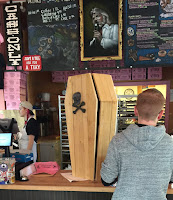One of the organizations we've long supported is
Episcopal Relief and Development, which "provides
relief in times of disaster and promotes
sustainable development by identifying and addressing the root causes of suffering." In other words ERD "gives a man a fish" for disaster relief but "teaches a man to fish" to make a permanent difference.
 |
| CEO Robert Radtke |
We spent the weekend at the
Vallombrosa Center in Menlo Park, where we were brought up to date with Episcopal Relief's mission and operations. Last year's expenditures were $23.3 million (programs $19.6, administration $1.1, fundraising $2.6). 90% of donated dollars go directly to programs because administration and fundraising are partially funded by investment income and service-subsidies from the Episcopal Church. That's the principal reason I like ERD--the dollars go where they're supposed to go. (
Charity Navigator gives the organization a four-star rating.)
Other takeaways:
1) Episcopal Relief has focused its sustained-development efforts on Women, Children, and Climate. While the latter is fraught with politics in the U.S. (because, IMHO, the climate-change movement tries to scold/strong-arm people into changing their behavior based on "science" that does
not explain contradictory phenomena), ERD
focuses on how families and communities can work together to adapt to the effects of rapidly changing weather patterns. This work includes preparing for and recovering from climate-influenced events such as floods, hurricanes and other disasters.
No scolding, no politics, just preparation and recovery.
2) Episcopal Relief has embraced
asset-based community development, which involves analyzing a community's existing assets (e.g., individuals, businesses, non-profit organizations, government) and their relationships. By marshaling these assets and relationships it's possible to effect positive change. In the United States "community organizing" has a negative connotation because of its association with wealth redistribution and identity politics, but in the so-called Third World the political element is much less emphasized. There is no rich uncle that can be tapped to save the community, it must save itself.
3) Episcopal Relief works alongside Anglican organizations who are "close to the ground" in order to make sure funds are spent judiciously. It declines to work in stricken areas where there is no Anglican presence. Such temperance is a point in its favor, IMHO.
4) Nearly half of donations are specified for aid for specific disasters (e.g., Haiti earthquake, Hurricane Sandy). Because funds are received fairly immediately, but disaster aid is spent--it's easy to waste--over a period of years, the accounting and ethical administration of these funds is not simple. I was impressed with the ERD leadership, which has clearly thought about this issue.
I have been critical about several aspects of the Episcopal Church. Episcopal Relief and Development is an example of the Church doing it right.

















































